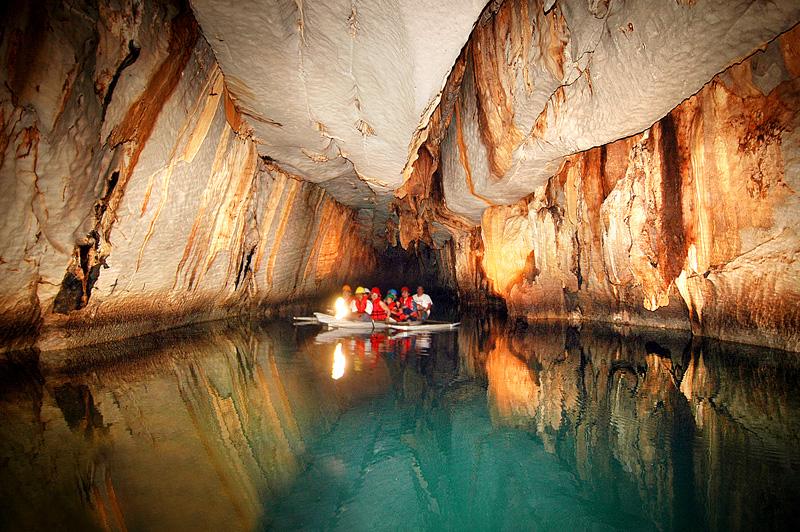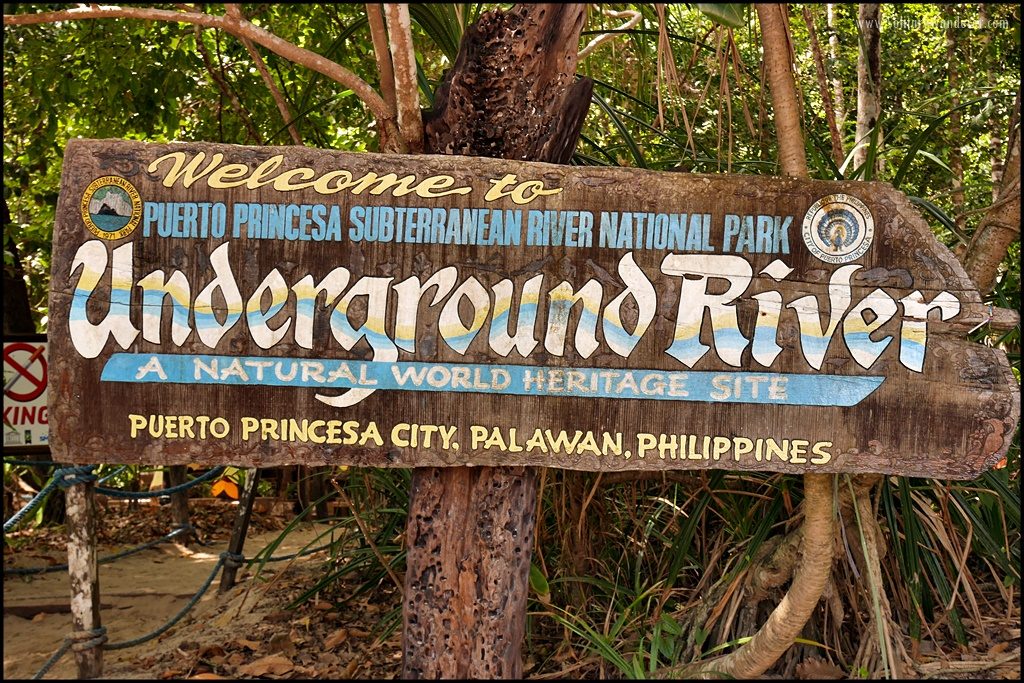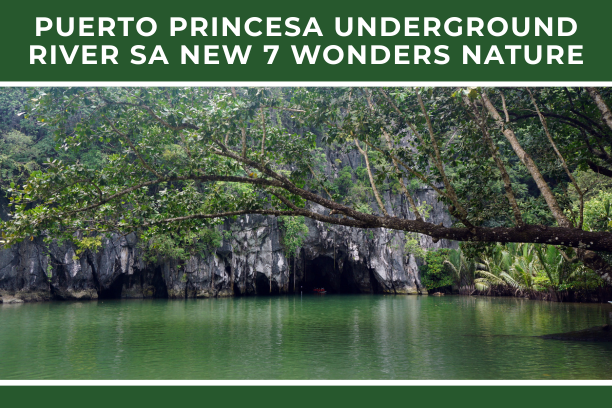The Puerto Princesa Underground River is a UNESCO World Heritage Site and one of the New 7 Wonders of Nature located in Palawan, Philippines.

The Puerto Princesa Subterranean River National Park (PPSRNP) is one of the most important protected areas of the Philippines. It features a spectacular limestone or karst landscape withone of the most complex cave systems. It contains an 8.2 km long underground river that flow directly to the sea. The lower half of the river is brackish and is affected by the ocean’s tide. An underground river directly flowing into the sea, and the associated tidal influence, makes it a significant natural phenomenon. The discovery of at least 11 minerals, crystal and egg shape rock formations, and a 20 million year old Miocene age serenia fossil in the cave further add to its scientific value. The Puerto Princesa Underground River is declared as one of the New 7 Wonders of Nature.
The PPSRNP contains a full mountain to the sea ecosystem and protect forests, which are among the most significant in Asia. It represents significant habitat that are important for biodiversity conservation.
In recognition of the PPSRNP’s globally significant natural value, it was inscribed to the List of World Heritage Sites on December 4, 1999. Inscription on the list confirms the outstanding universal value of the Park and it’s well integrated state of conservation.
In recognition of the PPSRNP’s globally significant natural value, it was inscribed to the List of World Heritage Sites on December 4, 1999. Inscription on the list confirms the outstanding universal value of the Park and it’s well integrated state of conservation. The PPSRNP is managed by the City Government of Puerto Princesa based on a program centered on environmental conservation and sustainable development. It has the distinction of being the first national park devolved and successfully managed by a Local Government Unit. It is managed by the City thru a Protected Area Management Board (PAMB), multi-sector body that provides policy direction and other oversight functions. It is a model for effective protected area management and sustainable tourism in the Philippines. The Puerto Princesa Subterranean River National Park is a source of pride, and a key element in the identity of the people of Puerto Princesa in particular, and of the Philippines as a whole. The conservation of the Park is a symbol of commitment by the Filipino people in the global efforts to conserve our natural heritage.
The Park was established on March 26, 1971, by virtue of Proclamation No. 835 issued by the late President Ferdinand E. Marcos. Formerly known as the St. Paul Subterranean National Park, it comprised of 3,901 hectares of terrestrial reservation. Experts later concluded that the size of the Park was inadequate to protect the water shed of the Underground River and the significant biodiversity present. To ensure long-term viability, Proclamation No. 212 was signed by President Joseph E. Estrada on November 16, 1999 expanding its area to 22,202 hectares that now includes the entire catchment for the Underground River and the forest ecosystems important for biodiversity conservation. It was also renamed to Puerto Princesa Subterranean River National Park to properly identifying it with the place.
The PPUR officially represented the Philippines in the global search for the New 7 Wonders of Nature. Pres. Benigno S. Aquino signed proclamation No. 182 on June 3, 2011 declaring a national and international campaign for the PPUR. This united Filipinos here and abroad who solidly supported the campaign and voted for inclusion of the Philippines to ssuch a prestigious list. The PPUR was declared as one of the New 7 Wonders of Nature on November 11, 2011.

There is no existing document that shows who or when the underground river was first discovered, but it is believed that the islands early inhabitants were the first to know of the existence, but their fear of spirits that they believe inhabit the caves prevented them from exploring the depts. The earliest mention one could hold of would be that of an Assistant Professor of Zoology at the University of Michigan who later became the Secretary of Interior at the first decade of American rule, Dean C. Worcester who wrote in 1887 while touring the island of Palawan “if accounts are to be believed, of a lake opening to the sea by a subterranean River”.

There are two types of weather prevailing in the area, the wet and dry season. It is usually wet from June to December and dry and hot the rest of the year. Average temperature is 29 C while the annual average rainfall is 1,148 mm/ yr. The average relative humidity is high at 85%.
The Park serves as a catchment to two important river systems, the Cabayugan River that flows down the slopes of Mt. Bloomfield, irrigating picturesque paddy farms before disappearing under Mt. St. Paul to become the underground river, and the Babuyan River measured at 53 km, the longest running river of the island. It provides water to local communities for domestic an agriculture use.
Topography varies from flat terrain to rolling hinterlands, from hills to mountain peaks. The three main peaks are Cleopatra’s Needle (1,500m), Mt. St. Paul (1,028m) and Mt. Bloomfield (870m). the limestone or karst outcrop known as the St. Paul mountain range. The karst is 11 km long, averages 3-5 km wide and covers an area of around 35 sq. /km. It is estimated to be between 16 – 20 million years old. The Park serves as a catchment to two important river systems, namely the Cabayugan River that flows down the slopes of Mt. Bloomfield, irrigating paddy farms before disappearing under Mt. St. Paul.
The Site contains a full mountain to sea ecosystem and protects some of the most significant forest area within Palawan Biogeographic Province. Eight forest formations are present: forest over limestone soils, they are composed of species that have adapted to very thin soil such as the Queensland umbrella tree (schefflera) and begonia; montane forest, of Cleopatra Needle (800-1,500 masl) east of the Park, vegetation is characterized by the growth of mosses, lichens and ferns; forest over ultramafic soil were vegetation is composed mostly of shrubs and trees growing to a height of not more than 1.5 meters infested with a scrambling bamboo species (Schizostachyum diffusum); lowland evergreen forest include species such as the Dracontomelon dao and Intia bijuga; riverine forest that include species such as the Homonoia riparia ; freshwater swamp forest are composed of tree species adapted to being partly submerged in water for part or most of the year; beach forest include Calophyllum inophyllum, Pongamia pinnata, and Pandamus sp; and mangrove forest along the Sabang river. Species identified belonged to the Rhizophoraceae family such as Rhizophora spp. and Bruguiera spp.
Flora of the Park represents more than a third of the entire flora of Palawan. At least 800 plant species of plants from 300 genera and 100 families have been identified in the Park. These include at least 295 trees dominated by the dipterocarp species.The diverse species of flora in and around the Park represents a very important gene pool of economically important plant species including rattans (Calamus sp), almaciga (Agathis philippinensis) and rambutan (Nephelium ramboutan-ake).
The faunal diversity in the PPSRNP is moderate with a total of 254terrestrial vertebrate species recorded. A total of 195 species of birds was recorded representing 67% of the total bird species and all of the 15 endemic bird species of Palawan. Notable species include the Blue-headed racquet-tail (Prioniturus platenae), Palawan hornbill (Anthracoceros marchei), Palawan scoops owl (Otus fuliginosus). There are also 30 species of mammals present in the Park. Most common is the long tailed macaque often observed in feeding in the forest canopy and along the shoreline during low tide. Other prominent species are Oriental small-clawed otter (Amblonyx cinereus), Palawan stink badger (Mydaus marchei), and Palawan Arrow-tailed flying squirrel (Hylopetes nigripes). Also notable are 8 species of bats that inhabit the cave. At least 19 species of reptiles have been recorded in the Park, of which 8 species are endemic. Species include large predators like the reticulated python (Python reticulates) and the monitor lizards, also present is the rare fresh water turtles (Caura ambionensis). Important species include the Green sea turtle (Chelonia mydas) and Hawksbill turtle (Eretmochelys imbricate), both internationally endangered species feed on the sea grass beds and nest in the white sand beaches of the St. Paul bay. Amphibians are the smallest group of vertebrates with only 10 species identified. Most dominant and frequently encountered is the Philippine woodland frog (Rana acanthi)
Invertebrate species are principally represented by insect fauna. Of insects surveyed, the Lepidoptera group that include species like butterflies like Trojana .The subterranean river is home to creatures that include Megalomorph spider, Thereupoda, and Amblypygius or tailess whip scorpion.
The marine component is small but important feature of the Site. It includes intertidal zones, seagrass beds, and coral reef. The condition of reefs in St. Paul bay is considered good with more than 57% cover. They are composed primarily of branching table corals with the presence of tabulated, encrusting and massive corals.
The faunal diversity in the PPSRNP is moderate with 254 terrestrial vertebrate species recorded., especially with respect to invertebrates. A total of 165 species of birds was recorded in PPSRNP representing 67% of the total bird species of Palawan. It is inhabited by 5 internationally threatened bird species including the Philippine cockatoo (Cacatua haematuropygia) and the Palawan peacock pheasant (Polyplectron emphanum),
There are also some 30 mammal species that have been recorded in the Park. Mammal species include the Park are Bearcat (Arctictis binturong), , the Palawan porcupine (Hystrix pumilus) and the long-tailed macaque (Macaca fascicularis). Also notable are 8 species of bats that inhabit the
cave.
There are 19 species of reptiles have been identified in the PPSRNP, of which 8 species are endemic. Reptiles species in the area include large predators like the Common reticulated python (Phython reticulatus), the Monitor lizard (Varanus salvator), and rare fresh water turtles (Caura ambionensis).
Amphibians are the smallest group of vertebrates with only 10 species identified. Most dominant and frequently encountered is the Philippine woodland frog (Rana acanthi), one species, Barbourula busuangensis, endemic to Palawan was also observed in the area.
Invertebrate species are principally represented by insect fauna. Of insects surveyed, the Lepidoptera group that include species like Trojana are the most commonly observed. The subterranean river is home to creatures that include Megalomorph spider, Thereupoda, and Amblypygius or tailess whip scorpion.
In the marine component, Green sea turtle (Chelonia mydas) and Hawksbill turtle (Eretmochelys imbricate), both internationally endangered species are also observed to nest in the white sand beaches and feed in the sea grass beds dominated by tropical eelgrass (Enhalus acoroides) species. Commonly seen species are the Horned starfish, Spotted sea cucumber, and Cigar wrasse.
Approximately two-thirds of the park is forested, dominated by hardwood species. Eight forest formations are found in the park: forest over ultramafic soils, forest over limestone soils, montane forest, freshwater swamp forest, lowland evergreen tropical rainforest, riverine forest, beach forest, and mangrove forest. In the coastal area, sea grass beds and coral reefs are also found. At least 800 plant species of plants from 300 genera and 100 families have been identified in the Park. These include at least 295 trees dominated by the dipterocarp species. The diverse species of flora in and around the Park represents a very important gene pool of economically important plant species including rattans (Calamus sp), almaciga (Agathis philippinensis).

Land-use consists of primary and secondary forest, brush land, grassland, cultivated lands and paddy fields. Primary forests still cover more than half of the Park and are designated for conservation purposes. Cultivated lands are found in and around most settlements and are largely allocated for rice paddies and fruit trees. Built up areas are concentrated along the road and coastline. Tourist establishments which makeup a large part of the development are concentrated in Sabang.
The limestone or karst formation is estimated to be 20 million years old and covers an area of around 35 sq. /km. The karst is 11 km long, differs from 3 to 5 km wide. The PPUR host 11 minerals including the rare mineral “ Serrabrancaite” or manganese phosphate that is formed from the mineralization of “guano”.
The Park serves as a catchment to two important river systems, namely the Cabayugan River that flows down the slopes of Mt. Bloomfield, irrigating paddy farms before disappearing under Mt. St. Paul to become the Underground River, and the Babuyan River which at 54 km, is the longest river in Palawan.
The surrounding areas are ancestral domains of the Batak and Tagbanua, two of the seven cultural groups of Palawan. Two CADC’s have been established to protect these indigenous cultural communities. It has a population of 3,829 individuals including around 400 members of the indigenous People. The majority of the population is composed of migrants from other parts of the island as well as from other regions of the Country. Majority of the people speak Pilipino, other dialects spoken include the local dialect Cuyunon, Ilocano and Cebuano.
Most household in the PPSRNP earn their living from farming except in Sabang where many household depend on fishing and tourism. Indigenous People are engaged in upland farming and gathering of minor forest products such as rattan poles, almaciga resin, and wild honey as the main source of income. They still resort to hunting game to add to their food requirements.With the international recognitions received by the Park, tourism is now the main economic activity.


The PPSRNP lies approximately 360 miles south of Manila. It is located in the midwest coast of Palawan, some 76 km northwest of Puerto Princesa City. The present boundary covers the entire catchment of the Underground River. The adjoining Barangay Marufinas also has important values, particularly for forest conservation. This is thus important in protecting World Heritage values of the Site. Its geographic coordinates are 10′ 10 north, 118′ 55 south.
Topography of the PPSRNP varies from flat terrain to rolling hinterlands, from hills to mountain peaks. The landscape is split at the center by a limestone or karst formation known as the St. Paul limestone. The main peaks are Mt. St. Paul (1,028m), Cleopatra’s Needle (1,500m) at the east and Mt. Bloomfield (870m) on the west. Park is underlain by rock formations consisting of recent alluvium, sandstone and shale. The recent alluvium is made up of transported clay, silt and pebbles. The limestone or karst formation is estimated to be 20 million years old, is 11 km long, average 4 km in width, and covers an area of around 35 sq. /km, The PPUR host a unusually high number of 11 minerals including the rare mineral “ Serrabrancaite” or manganese phosphate.

Its stunning limestone formations, diverse ecosystems, and unique geology have made it a UNESCO World Heritage Site.

It is located in Palawan, Philippines, a UNESCO World Heritage Site famous for its 5-mile-long underground river.

The Underground River is known for its unique limestone formations, adding another captivating attraction to the site.

Underground River is a popular destination visited by tourists and one of the main attractions in Palawan.

The park's diverse ecosystem supports plant life and shelters animals like macaques and rare spiders.

The 8-kilometer Cabayugan River is one of the world’s longest navigable underground rivers.

The Puerto Princesa Subterranean River National Park is a protected area of the Philippines located about 80 kilometres (50 mi) north of the city centre of Puerto Princesa, Palawan. The river is also called Puerto Princesa Underground River. The national park is located in the Saint Paul Mountain Range on the western coast of the island. It is bordered by St. Paul Bay to the north and the Babuyan River to the east. The City Government of Puerto Princesa has managed the National Park since 1992. The entrance to the subterranean river is a short hike or boat ride from the town Sabang.
In 2010, a group of environmentalists and geologists discovered that the underground river has a second floor, which means that there are small waterfalls inside the cave. They also found a cave dome measuring 300 m (980 ft) above the underground river, rock formations, large bats, a deep water hole in the river, more river channels, and another deep cave, as well as marine creatures and more. Deeper areas of the underground river are almost impossible to explore due to oxygen deprivation. On November 11, 2011, Puerto Princesa Underground River was provisionally chosen as one of the New7Wonders of Nature. This selection was officially confirmed on January 28, 2012.
The Puerto Princesa Underground River is a UNESCO World Heritage Site and one of the New 7 Wonders of Nature located in Palawan, Philippines.
Hon. Lucilo R. Bayron
City Mayor/ Chairman PAMB
New Green City Hall Complex, Brgy. Santa Monica
Puerto Princesa City, 5300
City Hall Telephone Number: +63(48)717-8001
Mobile:
Telefax:+63(48)717-8049
Email: citymayor@puertoprincesa.ph
Elzabeth Maclang
Protected Area Superintendent
Puerto Princesa Subterranean River National Park
Puerto Princesa City, 5300 Philippines
City Mayor's Office - City Management Information System Division
For Information and Bookings, please contact or visit us at:
Underground River Booking Office
Mendoza Park
Brgy. Model, Puerto Princesa City, Philippines
Tel. Nos. (048) 716 1522
E-mail: undergroundriver_ppsrnp@yahoo.com
Website: http://undergroundriver.puertoprincesa.ph
